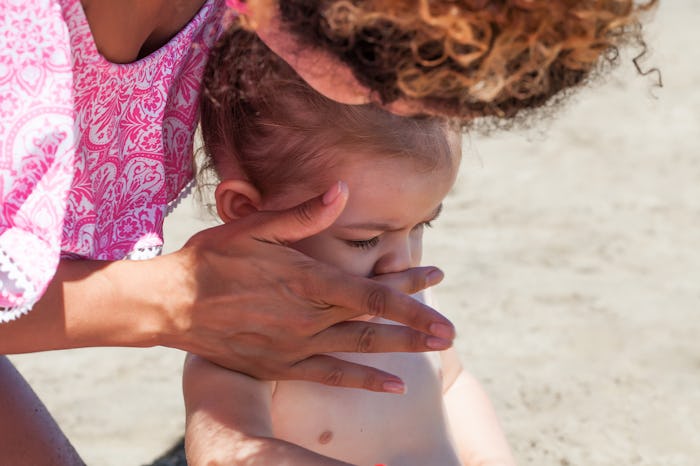Life

Putting Sunscreen On Your Kid Doesn't Have To Be A Fight — Here's How To Do It
I am almost translucent, so me and sunscreen are basically besties at this point. Even though my children are beautifully deep brown thanks to my husband's genetics, I still slather them like biscuits being buttered because I refuse to take risks with my children's skin. However, getting them to sit still for this process? Not so easy. Plus I'm always wondering if I'm doing it correctly. With all that's on the line, it seems essential to know how to put sunscreen on a child so that they get maximum coverage.
Surprisingly, most of us aren't using enough sunscreen when it comes to ourselves or our children. According to Wilmington Dermatology, a good rule of thumb is that the amount of sunscreen that you need to adequately cover a body is the amount that person can hold in their palm. Obviously you're not going to fill your child's hand with sunscreen, but you can use that idea as an estimate. Then, according to Wilmington Dermatology, you need to cover any bit of exposed skin on the body.
Let's be honest, for kids who are super energetic, that means the top of the bottom — because their pants or swim suit bottoms might fall a bit — and under the straps of any bathing suit or top that could also move about and fall off.
Dr. Carrie Coughlin of the St. Louis Children's Hospital instructed patients in a video, noting that you have to pay attention to where you start and where you finish. She suggested dotting each area of the body with sunscreen and then coming back to the area and massaging it into the skin. She also cautioned that you should be using a sunscreen with zinc oxide and titanium, which is known as a physical block. "The nice thing with using some of the physical blocks of sunscreen is that they are active as soon as you put them on. If you use some of the chemical blocks" — like oxybenzone or avobenzone — "they [children] have to wait 20 minutes or so before going out." She's super specific when it comes to application, instructing parents to make sure they don't forget the tips of ears, back of the neck, and if they're not wearing a sun hat — the scalp where their hair parts.
It's crucial that your children always wear it, too. Dr. Marla Ross, board certified dermatologist near Portland, Oregon told The Better Show that "their skin has no natural protection at that age, particularly infants and children are very sun-sensitive."
As far as which sunscreens you should be using when you dip your children like a Dairy Queen cone, you may want to skip the aerosol sunscreens. As of 2011, the FDA has been conducting research as to the possible effects of inhaling the micro-chemicals sprayed out from oh-so-convenient aerosol sunscreens. As late as 2016, the safety guide at Consumer Reports has cautioned against parents using it for their children.
The American Academy of Pediatrics (AAP) wrote that you should "use a broad-spectrum sunscreen with a sun protection factor (SPF) of at least 15 (up to SPF 50). An SPF of 15 or 30 should be fine for most people. More research studies are needed to test if sunscreen with more than SPF 50 offers any extra protection." As for the type? They're not incredibly specific, but the organization did note that "if possible, avoid the sunscreen ingredient oxybenzone because of concerns about mild hormonal properties." (That's one of the chemical sunscreens mentioned earlier.)
The AAP wrote that you should apply it at least 15 minutes before you go outside, and reapply every two hours. No sunscreen is waterproof, and it does diminish in strength after that period.
A pro tip from me? The easiest way to get your children to comply is to let them apply some on you at the same time. Sure, you'll need to do it again yourself, but it makes the process go much more smoothly. As for me, I'll just be hiding under my umbrella, hat, and long sleeves like the vampire I basically am.
Check out Romper's new video series, Bearing The Motherload, where disagreeing parents from different sides of an issue sit down with a mediator and talk about how to support (and not judge) each other’s parenting perspectives. New episodes air Mondays on Facebook.
This article was originally published on